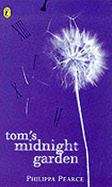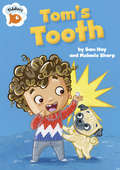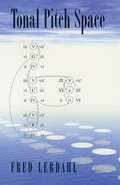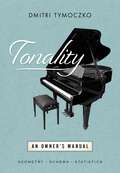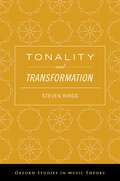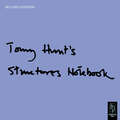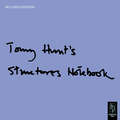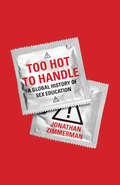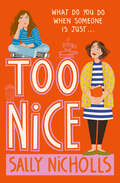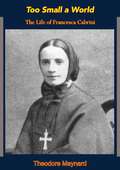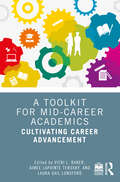- Table View
- List View
Tom's Midnight Garden (Puffin)
by Philippa PearceTom is not prepared for what is about to happen when he hears the grandfather clock strike thirteen. Outside the back door is a garden, which everyone tells him does not exist.
Tom's Midnight Garden (Puffin) (PDF)
by Philippa PearceTom is not prepared for what is about to happen when he hears the grandfather clock strike thirteen. Outside the back door is a garden, which everyone tells him does not exist.
Tom's Tooth (Tiddlers #127)
by Sam HayTom's Tooth is a fun story for all children expecting a visit from the tooth fairy and who are beginning to read on their own. Perfect for children aged 4+ who are reading at book band 2 red.Tom wiggles and jiggles his wobbly tooth until it's out. He's so happy but, at bedtime, he cannot find it. Can his brother and sister help?The Tiddlers series features fun stories with a word count of fewer than 50 words for children who are just starting to read. A word list at the beginning of the story allows for a quick check of the reader's ability to read and understand words before reading, and a spot the picture puzzle at the end of the story encourages rereading for pleasure. Compiled in consultation with Catherine Glavina, PGCE Primary and Early Years Course Leader, The Centre for Professional Education, University of Warwick.
Tonal Pitch Space
by Fred LerdahlBuilding on the foundation of Lerdahl and Jackendoff's influential A Generative Theory of Tonal Music, this volume presents a multidimensional model of diatonic and chromatic spaces that quantifies listeners' intuitions of the relative distances of pitches, chords, and keys from a given tonic. The model is employed to assign prolongational structure, represent paths through the space, and compute patterns of tension and attraction as musical events unfold, thereby providing a partial basis for understanding musical narration, expectation, and expression. Conceived as both a music-theoretic treatise and a contribution to the cognitive science of music, this book will be of interest to music theorists, musicologists, composers, computer musicians, and cognitive psychologists.
Tonal Pitch Space
by Fred LerdahlBuilding on the foundation of Lerdahl and Jackendoff's influential A Generative Theory of Tonal Music, this volume presents a multidimensional model of diatonic and chromatic spaces that quantifies listeners' intuitions of the relative distances of pitches, chords, and keys from a given tonic. The model is employed to assign prolongational structure, represent paths through the space, and compute patterns of tension and attraction as musical events unfold, thereby providing a partial basis for understanding musical narration, expectation, and expression. Conceived as both a music-theoretic treatise and a contribution to the cognitive science of music, this book will be of interest to music theorists, musicologists, composers, computer musicians, and cognitive psychologists.
Tonality: An Owner's Manual (OXFORD STUDIES IN MUSIC THEORY)
by Dmitri TymoczkoThis encyclopaedic book proposes a sweeping reformulation of the basic concepts of Western music theory, revealing simple structures underlying a wide range of practices from the Renaissance to contemporary pop. Its core innovation is a collection of simple geometrical models describing the implicit knowledge governing a broad range of music-making, much as the theory of grammar describes principles that tacitly guide our speaking and writing. Each of its central chapters re-examines a basic music-theoretical concept such as voice leading, repetition, nonharmonic tones, the origins of tonal harmony, the grammar of tonal harmony, modulation, and melody. These are flanked by two largely analytical chapters on rock harmony and Beethoven. Wide-ranging in scope, and with almost 700 musical examples from the Middle Ages to the present day, Tonality: An Owner's Manual weaves philosophy, mathematics, statistics, and computational analysis into a new and truly twenty-first century theory of music.
Tonality: An Owner's Manual (OXFORD STUDIES IN MUSIC THEORY)
by Dmitri TymoczkoThis encyclopaedic book proposes a sweeping reformulation of the basic concepts of Western music theory, revealing simple structures underlying a wide range of practices from the Renaissance to contemporary pop. Its core innovation is a collection of simple geometrical models describing the implicit knowledge governing a broad range of music-making, much as the theory of grammar describes principles that tacitly guide our speaking and writing. Each of its central chapters re-examines a basic music-theoretical concept such as voice leading, repetition, nonharmonic tones, the origins of tonal harmony, the grammar of tonal harmony, modulation, and melody. These are flanked by two largely analytical chapters on rock harmony and Beethoven. Wide-ranging in scope, and with almost 700 musical examples from the Middle Ages to the present day, Tonality: An Owner's Manual weaves philosophy, mathematics, statistics, and computational analysis into a new and truly twenty-first century theory of music.
Tonality and Transformation (Oxford Studies in Music Theory)
by Steven RingsTonality and Transformation is a groundbreaking study in the analysis of tonal music. Focusing on the listener's experience, author Steven Rings employs transformational music theory to illuminate diverse aspects of tonal hearing - from the infusion of sounding pitches with familiar tonal qualities to sensations of directedness and attraction. In the process, Rings introduces a host of new analytical techniques for the study of the tonal repertory, demonstrating their application in vivid interpretive set pieces on music from Bach to Mahler. The analyses place the book's novel techniques in dialogue with existing tonal methodologies, such as Schenkerian theory, avoiding partisan debate in favor of a methodologically careful, pluralistic approach. Rings also engages neo-Riemannian theory-a popular branch of transformational thought focused on chromatic harmony-reanimating its basic operations with tonal dynamism and bringing them into closer rapprochement with traditional tonal concepts. Written in a direct and engaging style, with lively prose and plain-English descriptions of all technical ideas, Tonality and Transformation balances theoretical substance with accessibility: it will appeal to both specialists and non-specialists. It is a particularly attractive volume for those new to transformational theory: in addition to its original theoretical content, the book offers an excellent introduction to transformational thought, including a chapter that outlines the theory's conceptual foundations and formal apparatus, as well as a glossary of common technical terms. A contribution to our understanding of tonal phenomenology and a landmark in the analytical application of transformational techniques, Tonality and Transformation is an indispensible work of music theory.
Tonality and Transformation (Oxford Studies in Music Theory)
by Steven RingsTonality and Transformation is a groundbreaking study in the analysis of tonal music. Focusing on the listener's experience, author Steven Rings employs transformational music theory to illuminate diverse aspects of tonal hearing - from the infusion of sounding pitches with familiar tonal qualities to sensations of directedness and attraction. In the process, Rings introduces a host of new analytical techniques for the study of the tonal repertory, demonstrating their application in vivid interpretive set pieces on music from Bach to Mahler. The analyses place the book's novel techniques in dialogue with existing tonal methodologies, such as Schenkerian theory, avoiding partisan debate in favor of a methodologically careful, pluralistic approach. Rings also engages neo-Riemannian theory-a popular branch of transformational thought focused on chromatic harmony-reanimating its basic operations with tonal dynamism and bringing them into closer rapprochement with traditional tonal concepts. Written in a direct and engaging style, with lively prose and plain-English descriptions of all technical ideas, Tonality and Transformation balances theoretical substance with accessibility: it will appeal to both specialists and non-specialists. It is a particularly attractive volume for those new to transformational theory: in addition to its original theoretical content, the book offers an excellent introduction to transformational thought, including a chapter that outlines the theory's conceptual foundations and formal apparatus, as well as a glossary of common technical terms. A contribution to our understanding of tonal phenomenology and a landmark in the analytical application of transformational techniques, Tonality and Transformation is an indispensible work of music theory.
Tony Hunt's Structures Notebook
by Tony HuntThe purpose of the Structures Notebook is to explain, in the simplest possible terms, about the structure of 'things', and to demonstrate the fact that everything you see and touch, live in and use, living and man-made, has a structure which is acted upon by natural forces and reacts to these forces according to its form and material.The Structures Notebook was originally written by Tony Hunt as a brief teaching aid for students at the Royal College of Art who had very little, if any, knowledge of physics or structural behaviour. It has now been expanded, and with this second edition, updated, into a more comprehensive book while retaining a simple visual and non-mathematical approach to structures.The book is divided into seven main sections, in a logical sequence, and is written in simple language. Each section, related to its text, has a comprehensive set of hand-drawn sketches which show, as simply as possible, what the text is about. The book is almost totally non-mathematical since the author believes very strongly that structural behaviour can be understood best by diagrams and simple descriptions and that mathematics for the majority of people interested in design is a barrier. The design of structures is a combination of art and science and to achieve the best solution, concept should always come before calculation.
Tony Hunt's Structures Notebook
by Tony HuntThe purpose of the Structures Notebook is to explain, in the simplest possible terms, about the structure of 'things', and to demonstrate the fact that everything you see and touch, live in and use, living and man-made, has a structure which is acted upon by natural forces and reacts to these forces according to its form and material.The Structures Notebook was originally written by Tony Hunt as a brief teaching aid for students at the Royal College of Art who had very little, if any, knowledge of physics or structural behaviour. It has now been expanded, and with this second edition, updated, into a more comprehensive book while retaining a simple visual and non-mathematical approach to structures.The book is divided into seven main sections, in a logical sequence, and is written in simple language. Each section, related to its text, has a comprehensive set of hand-drawn sketches which show, as simply as possible, what the text is about. The book is almost totally non-mathematical since the author believes very strongly that structural behaviour can be understood best by diagrams and simple descriptions and that mathematics for the majority of people interested in design is a barrier. The design of structures is a combination of art and science and to achieve the best solution, concept should always come before calculation.
Too Dirty!: All About Henry: Too Dirty! (Start Reading: All About Henry)
by Anne RooneyHenry and Axel, the dog, go for a walk in the park and they come back very dirty!
Too Hot to Handle: A Global History of Sex Education
by Jonathan ZimmermanToo Hot to Handle is the first truly international history of sex education. As Jonathan Zimmerman shows, the controversial subject began in the West and spread steadily around the world over the past century. As people crossed borders, however, they joined hands to block sex education from most of their classrooms. Examining key players who supported and opposed the sex education movement, Zimmerman takes a close look at one of the most debated and divisive hallmarks of modern schooling.In the early 1900s, the United States pioneered sex education to protect citizens from venereal disease. But the American approach came under fire after World War II from European countries, which valued individual rights and pleasures over social goals and outcomes. In the so-called Third World, sex education developed in response to the deadly crisis of HIV/AIDS. By the early 2000s, nearly every country in the world addressed sex in its official school curriculum. Still, Zimmerman demonstrates that sex education never won a sustained foothold: parents and religious leaders rejected the subject as an intrusion on their authority, while teachers and principals worried that it would undermine their own tenuous powers. Despite the overall liberalization of sexual attitudes, opposition to sex education increased as the century unfolded. Into the present, it remains a subject without a home.Too Hot to Handle presents the stormy development and dilemmas of school-based sex education in the modern world.
Too Hot to Handle: A Global History of Sex Education
by Jonathan ZimmermanToo Hot to Handle is the first truly international history of sex education. As Jonathan Zimmerman shows, the controversial subject began in the West and spread steadily around the world over the past century. As people crossed borders, however, they joined hands to block sex education from most of their classrooms. Examining key players who supported and opposed the sex education movement, Zimmerman takes a close look at one of the most debated and divisive hallmarks of modern schooling.In the early 1900s, the United States pioneered sex education to protect citizens from venereal disease. But the American approach came under fire after World War II from European countries, which valued individual rights and pleasures over social goals and outcomes. In the so-called Third World, sex education developed in response to the deadly crisis of HIV/AIDS. By the early 2000s, nearly every country in the world addressed sex in its official school curriculum. Still, Zimmerman demonstrates that sex education never won a sustained foothold: parents and religious leaders rejected the subject as an intrusion on their authority, while teachers and principals worried that it would undermine their own tenuous powers. Despite the overall liberalization of sexual attitudes, opposition to sex education increased as the century unfolded. Into the present, it remains a subject without a home.Too Hot to Handle presents the stormy development and dilemmas of school-based sex education in the modern world.
Too Nice
by null Sally NichollsAbby struggles with feelings of anxiety about school during a period of family upheaval in this sensitive and touching story from Sally Nicholls. Abby is used to it being just her and her dad at home, but now her dad’s new girlfriend Jen is moving in and everything is changing. It’s not like Jen is an evil stepmother, though. Instead, Abby’s problem is that Jen is just too nice! She constantly compliments Isla on everything from her appearance to her schoolwork, and Abby finds it fake and claustrophobic. But how can she explain to her dad how she feels when Jen hasn’t really done anything wrong?
Too Safe For Their Own Good?, Second Edition: Helping children learn about risk and life skills (PDF)
by Jennie LindonYoung children have a limited understanding of the risks surrounding them: they fall over, bang their heads, scrape their knees and worse. Parents and practitioners can try to create a risk-free environment, but this can reduce children's chances to to learn about risk and how to judge new situations. This bestselling guide shows how adults can share their own skills with young children to promote understanding of safety in a stimulating way. It covers key areas such as: putting risk into perspective; how children learn to take care of themselves; supporting children after accidents and avoiding preventable accidents; and working in partnership with parents. This second edition has been fully updated to reflect current practice, featuring new material on risk-benefit analysis and the importance of outdoor experiences. Too Safe for Their Own Good? will support any practitioner working with children under the age of 8 with the guidance they need to offer enough challenge to benefit children, and to avoid over-protection or careless practice.
Too Scared To Learn: Women, Violence, and Education
by Jenny HorsmanToo Scared to Learn explores the impact of women's experiences of violence on their learning, and proposes radical changes to educational programs through connecting therapeutic and educational discourses. Little attention has previously been paid to the impact of violence on learning. A large percentage of women who come to adult literacy programs have experienced, or are currently experiencing, violence in their lives. This experience of violence negatively affects their ability to improve their literacy skills. Literacy programs and other educational programs have not integrated this reality into their work. This book builds on extensive research that revealed the wide range of impacts violence has on adult literacy learning. Interviews with counselors and therapists, literacy learners, and educators working in different situations, and a wide range of theoretical and experiential literature, form the basis of the analysis. Educators are offered information to support reconceptualizing programs and practices and making concrete changes that will enable women to learn more effectively. The book makes clear that without an acknowledgment of the impact of violence on learning, women, rather than getting a chance to succeed and improve their literacy skills, get only a chance to fail, confirming to themselves that they really cannot learn. Essential reading for literacy and adult education practitioners, teachers of English as a second language, and education theorists, Too Scared to Learn explores the intersection among trauma, psychological theory, and pedagogy. The book is filled with a wealth of practical ideas, possibilities, and thoughts about what practitioners might do differently in classrooms and educational institutions if we begin to think differently about violence.
Too Scared To Learn: Women, Violence, and Education
by Jenny HorsmanToo Scared to Learn explores the impact of women's experiences of violence on their learning, and proposes radical changes to educational programs through connecting therapeutic and educational discourses. Little attention has previously been paid to the impact of violence on learning. A large percentage of women who come to adult literacy programs have experienced, or are currently experiencing, violence in their lives. This experience of violence negatively affects their ability to improve their literacy skills. Literacy programs and other educational programs have not integrated this reality into their work. This book builds on extensive research that revealed the wide range of impacts violence has on adult literacy learning. Interviews with counselors and therapists, literacy learners, and educators working in different situations, and a wide range of theoretical and experiential literature, form the basis of the analysis. Educators are offered information to support reconceptualizing programs and practices and making concrete changes that will enable women to learn more effectively. The book makes clear that without an acknowledgment of the impact of violence on learning, women, rather than getting a chance to succeed and improve their literacy skills, get only a chance to fail, confirming to themselves that they really cannot learn. Essential reading for literacy and adult education practitioners, teachers of English as a second language, and education theorists, Too Scared to Learn explores the intersection among trauma, psychological theory, and pedagogy. The book is filled with a wealth of practical ideas, possibilities, and thoughts about what practitioners might do differently in classrooms and educational institutions if we begin to think differently about violence.
Too Simple to Fail: A Case for Educational Change
by R. Barker BausellToo Simple to Fail presents a startling dissection of what is wrong with our educational system and a set of simple, common-sense steps for improving it. This simplicity, Bausell argues, characterizes both the schooling process and the science of education, as witnessed by legions of researchers who have discovered precious little that their grandmothers didn't already know. Yet surprisingly, based upon the author's own studies and a review of the past 30+ years of educational research, these discoveries boil down to a simple but powerful theory: The only way schools can increase learning is to increase the amount of relevant instructional time for all students. Here, Bausell demonstrates that classroom instruction is hopelessly obsolete, as are our current testing practices, both contributing to the widening opportunity gap between socioeconomic and racial groups. But with an understanding of what is wrong with education today comes the revelation that the answer to these deficiencies has been available to us all along in the form of the tutorial model, the most effective instructional paradigm ever developed. Only in recent years has it become feasible to simulate this extremely effective instructional medium as a universal option that, in effect, would allow schools to provide relevant instruction as a rule and not an exception. If implemented, a new world of opportunity and potential will finally be available to children, whose learning is so crucial for our future. The new model presented in this book has implications for identifying not only what is wrong with the way we educate our young, but also why it is wrong, and how the educational process can be made more efficient, effective, and fair.
Too Simple to Fail: A Case for Educational Change
by R. Barker BausellToo Simple to Fail presents a startling dissection of what is wrong with our educational system and a set of simple, common-sense steps for improving it. This simplicity, Bausell argues, characterizes both the schooling process and the science of education, as witnessed by legions of researchers who have discovered precious little that their grandmothers didn't already know. Yet surprisingly, based upon the author's own studies and a review of the past 30+ years of educational research, these discoveries boil down to a simple but powerful theory: The only way schools can increase learning is to increase the amount of relevant instructional time for all students. Here, Bausell demonstrates that classroom instruction is hopelessly obsolete, as are our current testing practices, both contributing to the widening opportunity gap between socioeconomic and racial groups. But with an understanding of what is wrong with education today comes the revelation that the answer to these deficiencies has been available to us all along in the form of the tutorial model, the most effective instructional paradigm ever developed. Only in recent years has it become feasible to simulate this extremely effective instructional medium as a universal option that, in effect, would allow schools to provide relevant instruction as a rule and not an exception. If implemented, a new world of opportunity and potential will finally be available to children, whose learning is so crucial for our future. The new model presented in this book has implications for identifying not only what is wrong with the way we educate our young, but also why it is wrong, and how the educational process can be made more efficient, effective, and fair.
Too Small a World: The Life of Francesca Cabrini
by Theodore MaynardToo Small a World is the bestselling biography of Mother Francesca Cabrini (1850-1917), an Italian-American religious sister who founded the Missionary Sisters of the Sacred Heart of Jesus, a Catholic religious institute, which became a major support to the Italian immigrants to the United States in the 19th century. Sister Cabrini was also the first naturalized citizen of the United States to be canonized by the Roman Catholic Church in 1946.Born in Northern Italy in 1850, Sister Cabrini was a woman of great compassion and courage. Inspired by her deep faith in Jesus Christ, she saw her life as a mission to relieve suffering and serve those in need—in particular the poor and excluded. Sister Cabrini established health, education and care centres in the U.S.A. and Latin America, Europe and England, becoming an inspiration to all those whose lives she touched.
A Tool for Determining e-Learning Readiness (SpringerBriefs in Educational Communications and Technology)
by Cathy James-Springer Katherine CennamoThis book presents a tool to determine e-learning readiness in workplace organizations. It offers a case study of the design and development process and outlines factors to be taken into account to determine e-learning readiness. It details the four objectives of this tool: to highlight specific parameters for determining e-learning readiness, to provide a systematic process to determine the readiness of an organization, to enable flexibility for the environmental context, and to capture the interrelatedness of the many areas in the organization. Next, it discusses the main element of the tool: surveys that are used to facilitate collection of data on organizational, learner and technology readiness. The book concludes with a look at practical ways of using the information gathered from the data produced.
A Toolkit for Creative Teaching in Post-Compulsory Education (UK Higher Education OUP Humanities & Social Sciences Education OUP)
by Linda Eastwood Jennie Coates Liz Dixon Josie Harvey Chris Ormondroyd Sarah WilliamsonAre you looking for ways to encourage learners to think more creatively? Do you need ideas for fun and engaging activities for individuals and groups? Would you like a practical step-by-step guide written by practitioners for practitioners? YES? Then this is the book for you!This is the essential resource for trainees and teachers working in the PCET sector who are looking for new and creative ways of engaging and motivating their learners.The book contains 50 brilliant activities that can be used in a variety of settings and applied to different subject areas. The authors give specific details relating to planning, preparation and implementation for each activity and, in addition, suggest a whole range of further variations for each activity to try out too!Key features include: 50 practical and innovative teaching activities Practical tips to get the most from each activity Variations and subject-specific examples Thinking Points to encourage reflection What Next signposts to further reading A theoretical framework which sets the activities within the context of creativity and innovation A Toolkit for Creative Teaching in Post-Compulsory Education is an essential handbook for teacher training students and for new and experienced teachers undertaking Professional Development.
A Toolkit for Mid-Career Academics: Cultivating Career Advancement
by Vicki L. Baker Aimee LaPointe Terosky Laura Gail LunsfordMid-career faculty are the backbone of the college and university workforce and represent the largest population of faculty in the academy, yet they face myriad challenges that hinder career satisfaction and advancement.This book offers action-oriented tools to engage (or re-engage) mid-career programming at the individual faculty, institutional, consortial, and grant-funded levels. Bringing together leading scholars and practitioners engaged in research and practice, this edited volume offers solutions to two driving questions faced by mid-career faculty: “what’s next" and “how to navigate.” This focus on both what and how highlights critical issues and challenges associated with mid-career coupled with specific tools and strategies to successfully navigate from diverse stakeholder perspectives. Jargon-free and rich with stories from the field, each chapter can serve as a stand-alone resource, be read in order as presented, or be read non-sequentially based on the reader’s specific needs.Mid-career faculty, including non-tenure-track and community college academics, will welcome the resources, tools, and strategies featured throughout this book, the “pocket professional development mentor” to help create more inclusive and equitable programming at multiple levels.
A Toolkit for Mid-Career Academics: Cultivating Career Advancement
by Vicki L. Baker Aimee LaPointe Terosky Laura Gail LunsfordMid-career faculty are the backbone of the college and university workforce and represent the largest population of faculty in the academy, yet they face myriad challenges that hinder career satisfaction and advancement.This book offers action-oriented tools to engage (or re-engage) mid-career programming at the individual faculty, institutional, consortial, and grant-funded levels. Bringing together leading scholars and practitioners engaged in research and practice, this edited volume offers solutions to two driving questions faced by mid-career faculty: “what’s next" and “how to navigate.” This focus on both what and how highlights critical issues and challenges associated with mid-career coupled with specific tools and strategies to successfully navigate from diverse stakeholder perspectives. Jargon-free and rich with stories from the field, each chapter can serve as a stand-alone resource, be read in order as presented, or be read non-sequentially based on the reader’s specific needs.Mid-career faculty, including non-tenure-track and community college academics, will welcome the resources, tools, and strategies featured throughout this book, the “pocket professional development mentor” to help create more inclusive and equitable programming at multiple levels.
